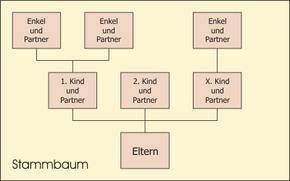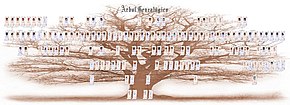family tree

A family tree ( modern loan transfer from Middle Latin arbor consanguinitatis "tree of consanguinity ") is in the general sense the tree-shaped representation of the descent of living beings, things or ideas from one another, starting from one or two underlying specimens at the tree root. In family research ( genealogy ), a family tree is the representation of the descendants known by name of a (former) person or couple; the person or the couple is displayed at the bottom with connecting lines branching upwards to their “descendants” and their descendants.
Colloquially, the presentation of a is under a root tree also falsely lineage or strain list in the form of a tree trunk understood ( "family tree"), in which only the succession in the fathers line to the oldest conjugal son over several generations is imaged. As a result, this representation only contains a very small section of the descendants of the original ancestral parents , because all ancestors of the respective mothers as well as the siblings of the heir sons and their descendants are not taken into account, the representation lacks the branches in the side lines . Even GenWiki , known in genealogical circles, defines family tree as such a male line. A historical model for this form of representation is the Jesse tree ( root Jesse ) , a widespread pictorial motif in Christian art , especially in the Middle Ages , which is supposed to depict a family tree of Jesus Christ (see also Tree of Life in the history of religion).
The opposite of a family tree, which is the representation of a person's ancestors, is properly referred to as a pedigree (or ancestor table) . The Duden also incorrectly describes the meaning of family tree as “evidence of as many ancestors as possible” and equates it with a “pedigree table” (pedigree). The change from descendant to ancestry and how "as many ancestors as possible" should be represented in the form of a tree that tapers downwards is also wrong with this understanding .
Other forms of representation of family relationships are the descendant table or the descendant list , with the initial person on top or on the left. From a genealogical point of view, a family tree is only spoken of when the graphic representation is in tree form (see also the tree concept in graph theory ). Family trees are also created for animal or plant individuals , figuratively also for objects and ideas ( see below ).
A combination of ancestors and descendants is the kinship chart used in genealogy, in which the parents and further ancestors and children and further descendants of a person or a couple are shown. From the form of the representation, this is also called an hourglass representation.
A complex, comprehensive representation of the relationship of a person or family is the genogram .
history
In ancient times, such representations were adorned with rich ornaments and figures , going back to the biblical passage of the root Jesse (Isa. 11: 1) .
In the early Middle Ages , highborns represented their uniqueness and sanctity of their kinship relationships (blood line). From the High Middle Ages to the beginning of the modern era, evidence of being of noble blood (having a certain number of free-born ancestors) was important in order to be eligible for knighthood and participation in tournaments to obtain, in a broader sense, the right to enter an order of knights or a noble cathedral or monastery chapter . This form of presentation - often decorated with coats of arms is as Aufschwörung called Stafel. Relationships were important in marriage and inheritance law at that time. The pursuit of prominent, fabulous ancestors as far back as possible led occasionally to absurd claims of ancestry.
Terms and forms of representation
Kinship and ancestry can be described in different ways. In addition to the graphical representation in tree form, lists are also common, which are more space-saving:
| designation | graphic | list |
|---|---|---|
| all offspring | Family tree, descendant table | Descendant list |
| all ancestors | Pedigree | Ancestral list |
| Ancestors and descendants of a person | Relatives table | Relatives lists |
| male, firstborn offspring of a person | Trunk line | Tribe list |
Representation in tree form
In the family tree, the parent mother and / or the parent father is shown as a reference person at the bottom, as it were as the root of a tree. The children and their descendants can be found in the branches above; in every generation of siblings, the older sibling is to the left of the younger, regardless of gender . The representation can be done schematically or decoratively decorated.
Family trees exist in different forms. Traditional family trees have focused on a “ lineage ” with predominantly male descendants (and heirs ) of the ancestors, along with their wives . For example, only people with the same family name were included; since married daughters took their husbands' names, they fell out of such family trees of their own family members .
With regard to the medical diagnosis of hereditary diseases , however, the female and male biological lineages are of equal importance, for example in human genetic counseling . Modern genealogy therefore strives for extensive ancestral lists that include all lineages - instead of lineages that are limited to the male side of the lineage.
Genealogical data collection
The creation of a person's family tree requires time-consuming research into the exact dates of all ancestors and, if applicable, descendants; this gathering of information can take many years. Only when the original “top ancestor ” ( ancestral mother , ancestral father ) has been reached can the graphical representation of the collected family information be started.
The first point of contact are the family registers of the parents or grandparents . Registry offices and parishes with their church records are the next level of data collection. If an existing local family book can be accessed, an extensive compilation can already be found there. The data can be supplemented by searches in the ancestral index of the German people and the ancestral list collection without having to look at the underlying sources.
Sooner or later the search comes to a “ deadlock ”. At the latest with the end or the historical beginning of the church book record, other sources are required. Old tax lists can provide further information. Online research on the Internet is a gain in time, but it can only be used with great caution and only for source support. Many genealogy forums offer GEDCOM files from private research for download.
Animal breeding
In animal breeding , for example pedigree dogs or farm animals , breeding studbooks provide an overview of all breeding animals of a breed. They each contain the ancestors and descendants of the registered breeding animals, possibly with their special characteristics. The young animals each receive breeding papers, which for horses are called proof of parentage . For horses, the pedigree is often called the pedigree (see also breeding value estimation , breed standards ).
Family trees in other areas
The term “family tree” is also used in other areas of application that have to do with descent and heredity. They use the same image and the same system for objects or subject areas that have diverged:
- Within genetics, “ family tree analyzes ” are used and there is the “molecular family tree” of archaeogenetics (see also “genetic bottleneck” in humans , mitochondrial Eve , Adam of the Y chromosome ).
- In bioinformatics and evolutionary biology, the “ family tree of evolution ” begins with a hypothetical common ancestor of all known biological species on earth and then continues to fan out according to their relationships (see also phylogenetic systematics ).
- In epistemology, attempts were made early on to create a “ family tree of the sciences ”.
- In linguistics there was the " family tree theory " of the development of different languages from assumed original languages until around 1900 .
- Within literary textual criticism, a “family tree” ( stemma ) is created from manuscripts that have been copied from one another.
- In computer science there is the "family tree of programming languages ", which begins around 1843 with the first programming activities of the British Lady Ada Lovelace ; The programming language Ada was named after her in the 1970s .
- In the sciences, an academic family tree shows scientific schools that reveal traditions and developments within a scientific discipline.
See also
- Consanguinity table · Affinity table
- Heir (Erbnachfolger) · ancestors Community (distant relatives) · Origin forecast (Ansippung)
- Relationships · Generation names · Genealogical signs and symbols · Computer Genealogy
Web links
- Franz Embacher: About graphs, genes and the WWW. Online script. Institute for Mathematics, University of Vienna, 2003 (mathematical: trees, roots and leaves, animals and people; script for the course “Extra-mathematical applications in mathematics lessons” in the 2003 summer semester).
Individual evidence
- ^ Peter CA Schels: Family Tree. ( Memento from March 4, 2016 in the Internet Archive ) In: Mittelalter Lexikon. Private wiki. February 8, 2014, accessed June 29, 2019.
- ^ GenWiki entry: Family tree. Verein für Computergenealogie , August 6, 2017, retrieved on June 29, 2019 : "A family tree in the sense of genealogy is a graphic representation of that part of the progeny of a test person, which is male line-based, based on a natural tree."
-
^ Duden online : family tree. Retrieved June 29, 2019 .
Quote: “Family tree, the […] meanings: 1. List of the relationships between humans (including animals) to describe the origin by proving as many ancestors as possible, often in the form of a graphic representation or a pictorial representation in the form of a branching tree; Pedigree […] 2. Description of the natural relationships between systematic units of the animal and plant kingdoms, often illustrated as a pictorial or graphic representation […] Synonyms for family tree: Pedigree, genealogy, genealogical table, family tree ; (elevated) pedigree ”.
Ibid: Pedigree: “Meanings: 1. genealogical table on which the ancestors of a person are given in ascending line; Usage: elevated […] 2. Overview of the ancestors of a breeding animal sorted by generations with information on the respective characteristics […] Synonyms for pedigree: pedigree, sex register, family tree, pedigree ”.
Ibid: Pedigree table : "Meaning: family tree (especially of a pedigree horse, dog) [...] Synonyms for pedigree table : pedigree, family tree".
- ↑ lbaibl: Conservation in practice: pedigree, part I. Landschaftsverband Westfalen-Lippe , August 17, 2015, accessed on June 29, 2019.


